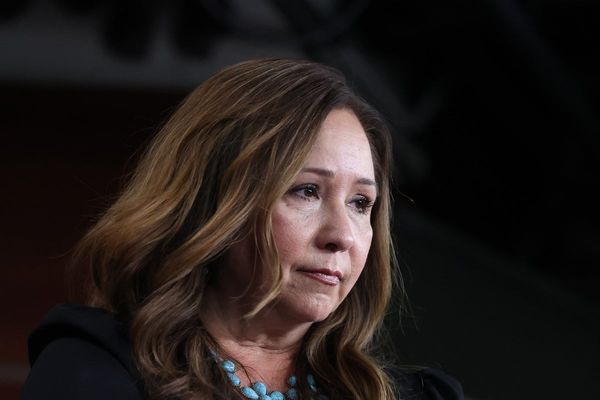WASHINGTON — Many Latino voters sat out California’s primary election last month, according to counts by Political Data, which tracks voter trends.
Only 15% of the nearly 6 million registered Latino voters returned their ballots, estimates by Political Data of July 13 show. This is compared to 31% of voters who identified as white or “other,” 24% of Asian voters and 25% of Black voters.
Latino voters tend to cast ballots later than others, experts said, which means their ballots get counted later. Percentages could change after California’s Secretary of State certifies results on July 15, though many experts predict not by much.
“Maybe Latinos end up being 21% of the total votes cast. They’re like 27% of the electorate,” said Paul Mitchell, vice president of Political Data. “That’s kind of what happens.”
Hispanic and Latino people make up the largest ethnic group in California — almost 40% of the population, as of the 2020 United States Census.
Hispanic voters make up a majority in three of the San Joaquin Valley’s new congressional districts, two of which are toss-ups for either Democrats or Republicans in a year in which experts predict a national “red wave” will hand GOP control of the House of Representatives.
But right now, “neither party is earning their vote,” said Pablo Rodriguez, the founding executive director of Communities for a New California Education Fund, a voter engagement nonprofit.
Low Latino primary turnout is cyclical
Rodriguez said candidates prior to June 7 were paying attention to an older, whiter electorate who are historically more likely to vote in primary elections than younger voters of color.
While many candidates in the San Joaquin Valley focus a lot on agriculture, such as water for farming, Rodriguez said that Latino voters want more attention on workers’ and household issues: jobs, the economy, housing and health care.
Latinos surveyed also cited housing affordability, inflation and cost of living as the top three issues they want elected officials to address, according to an April poll by the Latino Community Foundation.
Jacqueline Garcel, executive director for the Latino Community Foundation, said candidates need to improve at “listening to Latino voters.”
Matching historical trends, younger voters, voters of color and third- and no-party preference voters were less likely to return ballots this year than older, whiter and Democrat-or-Republican ones.
A growing number of Latinos are independents, Rodriguez said, making the tendency of low primary turnout by people without a party preference and Latinos a “double whammy.” And the average Latino voter is younger, said Mitchell.
About 33% of registered voters cast ballots in the primary election. Turnout appeared low on election night, but more Californians voted last month than in any previous gubernatorial primary, Mitchell said.
California voter trends
Hispanic voters hold the majority of the electorate in the 13th Congressional District around Merced, the 21st around Fresno and the 22nd around Hanford and Bakersfield. While the Democratic incumbent in the 21st, Rep. Jim Costa, is expected to win in the fall, experts say the contests in the 13th and 22nd could go either way.
The Central Valley has never elected a Latino lawmaker to the U.S. House. Democrats hope Assemblyman Rudy Salas, D-Bakersfield, could be the first in the left-leaning 22nd district if he defeats incumbent Rep. David Valadao, R-Hanford.
“The problem that Salas and other candidates in the Central Valley has is Latinos, we make it really easy for them to not show up,” said Democratic consultant Andrew Acosta.
Over half of Latino voters in Central Valley congressional districts are Democrats. Almost 30% are independents or do not have a party preference. About 17% are Republicans.
In states like Florida and Texas, Hispanic voters have trended more Republican recently, though California Republican consultant Matt Rexroad cautioned against the false perception that Latino voter preferences fall into the “same voting bucket.”
In prior California elections, Latino voters have been seen as aiding the Democratic firewall.
“Even if there is a wave across the country, if the Democrats address these issues that are important to Latino and particularly Latina voters in the fall, then that firewall could still be there,” Rodriguez said.
November midterm election
The Latino Community Foundation recently announced a partnership with 13 organizations in California to mobilize voters for the midterm election.
“People disengage when they feel like no one is going to make a difference in their lives, and we need to change that,” Garcel said.
Key for candidates in November, Rodriguez said, is getting support from Latina voters — a growing voter group in the Central Valley focused on economic fallout, bleak job opportunities, housing issues and toxic drinking water and health issues from climate issues.
Rodriguez said if candidates want to earn the Latino vote, reach out to more than just “likely voters,” hire Latino staff and post advertisements that are bilingual and, importantly, bicultural.
“The San Joaquin Valley is the richest agricultural region in the world,” Rodriguez said. “If harvests of grapes, almonds, oranges, etc. don’t yield what we expect, we don’t blame the crops. We carefully examine the our environment and our process. The same needs to apply to Latino voter turnout.”







